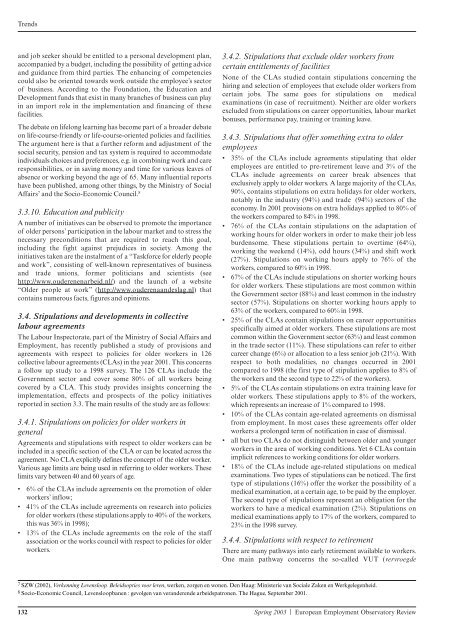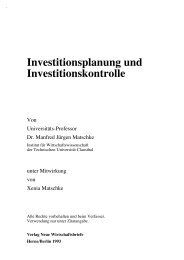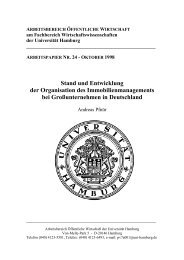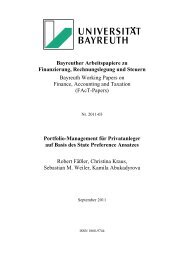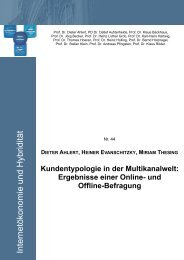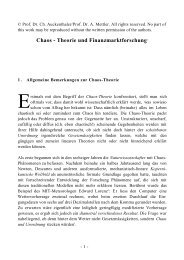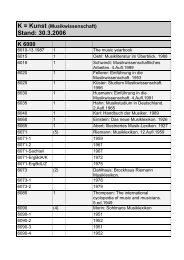FRANCE The
FRANCE The
FRANCE The
You also want an ePaper? Increase the reach of your titles
YUMPU automatically turns print PDFs into web optimized ePapers that Google loves.
Trends<br />
and job seeker should be entitled to a personal development plan,<br />
accompanied by a budget, including the possibility of getting advice<br />
and guidance from third parties. <strong>The</strong> enhancing of competencies<br />
could also be oriented towards work outside the employee’s sector<br />
of business. According to the Foundation, the Education and<br />
Development funds that exist in many branches of business can play<br />
in an import role in the implementation and financing of these<br />
facilities.<br />
<strong>The</strong> debate on lifelong learning has become part of a broader debate<br />
on life-course-friendly or life-course-oriented policies and facilities.<br />
<strong>The</strong> argument here is that a further reform and adjustment of the<br />
social security, pension and tax system is required to accommodate<br />
individuals choices and preferences, e.g. in combining work and care<br />
responsibilities, or in saving money and time for various leaves of<br />
absence or working beyond the age of 65. Many influential reports<br />
have been published, among other things, by the Ministry of Social<br />
Affairs7 and the Socio-Economic Council. 8<br />
3.3.10. Education and publicity<br />
A number of initiatives can be observed to promote the importance<br />
of older persons’ participation in the labour market and to stress the<br />
necessary preconditions that are required to reach this goal,<br />
including the fight against prejudices in society. Among the<br />
initiatives taken are the instalment of a “Taskforce for elderly people<br />
and work”, consisting of well-known representatives of business<br />
and trade unions, former politicians and scientists (see<br />
http://www.ouderenenarbeid.nl/) and the launch of a website<br />
“Older people at work” (http://www.ouderenaandeslag.nl) that<br />
contains numerous facts, figures and opinions.<br />
3.4. Stipulations and developments in collective<br />
labour agreements<br />
<strong>The</strong> Labour Inspectorate, part of the Ministry of Social Affairs and<br />
Employment, has recently published a study of provisions and<br />
agreements with respect to policies for older workers in 126<br />
collective labour agreements (CLAs) in the year 2001. This concerns<br />
a follow up study to a 1998 survey. <strong>The</strong> 126 CLAs include the<br />
Government sector and cover some 80% of all workers being<br />
covered by a CLA. This study provides insights concerning the<br />
implementation, effects and prospects of the policy initiatives<br />
reported in section 3.3. <strong>The</strong> main results of the study are as follows:<br />
3.4.1. Stipulations on policies for older workers in<br />
general<br />
Agreements and stipulations with respect to older workers can be<br />
included in a specific section of the CLA or can be located across the<br />
agreement. No CLA explicitly defines the concept of the older worker.<br />
Various age limits are being used in referring to older workers. <strong>The</strong>se<br />
limits vary between 40 and 60 years of age.<br />
• 6% of the CLAs include agreements on the promotion of older<br />
workers’ inflow;<br />
• 41% of the CLAs include agreements on research into policies<br />
for older workers (these stipulations apply to 40% of the workers,<br />
this was 36% in 1998);<br />
• 13% of the CLAs include agreements on the role of the staff<br />
association or the works council with respect to policies for older<br />
workers.<br />
3.4.2. Stipulations that exclude older workers from<br />
certain entitlements of facilities<br />
None of the CLAs studied contain stipulations concerning the<br />
hiring and selection of employees that exclude older workers from<br />
certain jobs. <strong>The</strong> same goes for stipulations on medical<br />
examinations (in case of recruitment). Neither are older workers<br />
excluded from stipulations on career opportunities, labour market<br />
bonuses, performance pay, training or training leave.<br />
3.4.3. Stipulations that offer something extra to older<br />
employees<br />
• 35% of the CLAs include agreements stipulating that older<br />
employees are entitled to pre-retirement leave and 3% of the<br />
CLAs include agreements on career break absences that<br />
exclusively apply to older workers. A large majority of the CLAs,<br />
90%, contains stipulations on extra holidays for older workers,<br />
notably in the industry (94%) and trade (94%) sectors of the<br />
economy. In 2001 provisions on extra holidays applied to 80% of<br />
the workers compared to 84% in 1998.<br />
• 76% of the CLAs contain stipulations on the adaptation of<br />
working hours for older workers in order to make their job less<br />
burdensome. <strong>The</strong>se stipulations pertain to overtime (64%),<br />
working the weekend (14%), odd hours (34%) and shift work<br />
(27%). Stipulations on working hours apply to 76% of the<br />
workers, compared to 60% in 1998.<br />
• 67% of the CLAs include stipulations on shorter working hours<br />
for older workers. <strong>The</strong>se stipulations are most common within<br />
the Government sector (88%) and least common in the industry<br />
sector (57%). Stipulations on shorter working hours apply to<br />
63% of the workers, compared to 60% in 1998.<br />
• 25% of the CLAs contain stipulations on career opportunities<br />
specifically aimed at older workers. <strong>The</strong>se stipulations are most<br />
common within the Government sector (63%) and least common<br />
in the trade sector (11%). <strong>The</strong>se stipulations can refer to either<br />
career change (6%) or allocation to a less senior job (21%). With<br />
respect to both modalities, no changes occurred in 2001<br />
compared to 1998 (the first type of stipulation applies to 8% of<br />
the workers and the second type to 22% of the workers).<br />
• 5% of the CLAs contain stipulations on extra training leave for<br />
older workers. <strong>The</strong>se stipulations apply to 8% of the workers,<br />
which represents an increase of 1% compared to 1998.<br />
• 10% of the CLAs contain age-related agreements on dismissal<br />
from employment. In most cases these agreements offer older<br />
workers a prolonged term of notification in case of dismissal.<br />
• all but two CLAs do not distinguish between older and younger<br />
workers in the area of working conditions. Yet 6 CLAs contain<br />
implicit references to working conditions for older workers.<br />
• 18% of the CLAs include age-related stipulations on medical<br />
examinations. Two types of stipulations can be noticed. <strong>The</strong> first<br />
type of stipulations (16%) offer the worker the possibility of a<br />
medical examination, at a certain age, to be paid by the employer.<br />
<strong>The</strong> second type of stipulations represent an obligation for the<br />
workers to have a medical examination (2%). Stipulations on<br />
medical examinations apply to 17% of the workers, compared to<br />
23% in the 1998 survey.<br />
3.4.4. Stipulations with respect to retirement<br />
<strong>The</strong>re are many pathways into early retirement available to workers.<br />
One main pathway concerns the so-called VUT (vervroegde<br />
7 SZW (2002), Verkenning Levensloop. Beleidsopties voor leren,werken, zorgen en wonen. Den Haag: Ministerie van Sociale Zaken en Werkgelegenheid.<br />
8 Socio-Economic Council, Levensloopbanen : gevolgen van veranderende arbeidspatronen. <strong>The</strong> Hague, September 2001.<br />
132 Spring 2003 | European Employment Observatory Review


